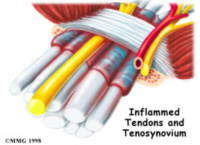Carpal Tunnel Syndrome
 In the wrist, the carpal bones and ligament form an opening or "tunnel." This opening is called the carpal tunnel. The median nerve and all the tendons attached to the muscles that flex or bend the fingers pass through the carpal tunnel.
In the wrist, the carpal bones and ligament form an opening or "tunnel." This opening is called the carpal tunnel. The median nerve and all the tendons attached to the muscles that flex or bend the fingers pass through the carpal tunnel.
Any condition that makes the area inside the carpal tunnel smaller, or increases the size of the tissues inside the tunnel can lead to carpal tunnel syndrome. Certain conditions that occur at work have been associated with the development of carpal tunnel syndrome. An example would be bending the wrist many times and applying force at the same time. This condition can cause the tendons to thicken from the irritation and inflammation. As the tendons increase in size, the space within the carpal tunnel decreases, causing the median nerve to be squeezed. This pressure results in damage to the median nerve.
Symptoms of carpal tunnel syndrome include numbness, tingling and pain in the hands (thumb and first three fingers). Symptoms are often most acute at night, while sleeping. Pain may spread up the arm to the shoulder and to the side of the neck. Advanced cases may also result in weakness and clumsiness of the hand as the thumb muscles weaken. It may become difficult to grab a steering wheel, telephone or hammer.